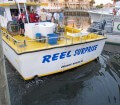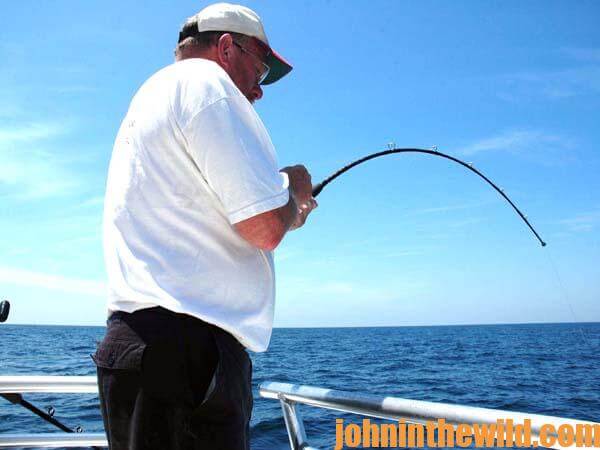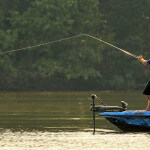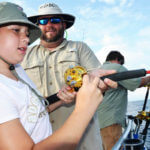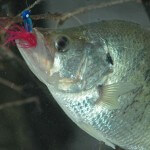I felt a tap on the line, and I waited. As the tip of my rod slowly descended into the salt water of the Gulf of Mexico below me, I began to wind the reel. Immediately, the drag slipped and fed out line at a steady pace, but I kept my rod parallel to the water. I didn’t jerk the rod up like you’d set the hook on a largemouth bass, and I didn’t try to turn the handle on the reel. As the drag kept tension on the line, I let the line feed off the reel. Once the drag stopped, and the pressure on the rod lessened, I turned the handle on the reel. I remembered Captain Randy Boggs saying, “You’re fishing with a circle hook. If you try to set the hook when the fish strikes, you’ll pull the hook and the bait out of the fish’s mouth. Just let the fish pull against the line. The circle hook will turn over in the fish’s mouth and catch it in the corner of its mouth.”
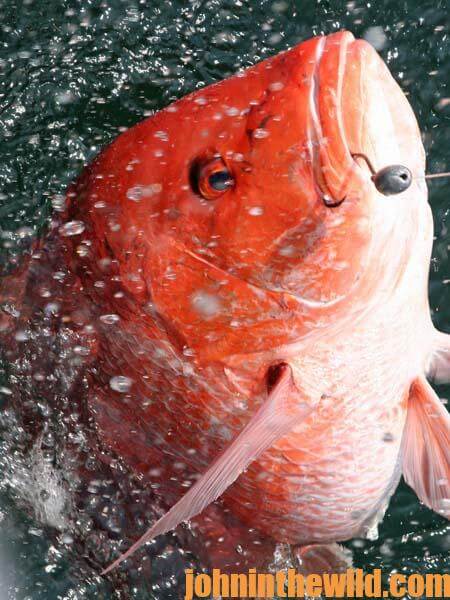 As I would get about 10 turns on the reel, the fish would take about 15 turns of line off the reel. Many times, when you get a big fish on the line, the first thought that enters your mind is to reel fast and get the fish in the boat – just like we see professional bass fishermen bring in big bass on television. But on this particular party boat, we were fishing with 60-pound-test line and a wire circle hook. In the past, I had fished with 80-to-100-pound-test line and strong stainless-steel hooks. However, the reef fish on Alabama’s Gulf Coast have learned what big line and big hooks look like, and the larger fish will stay away from that size of terminal tackle.
As I would get about 10 turns on the reel, the fish would take about 15 turns of line off the reel. Many times, when you get a big fish on the line, the first thought that enters your mind is to reel fast and get the fish in the boat – just like we see professional bass fishermen bring in big bass on television. But on this particular party boat, we were fishing with 60-pound-test line and a wire circle hook. In the past, I had fished with 80-to-100-pound-test line and strong stainless-steel hooks. However, the reef fish on Alabama’s Gulf Coast have learned what big line and big hooks look like, and the larger fish will stay away from that size of terminal tackle.
When we go fishing, one of the problems we all have is allowing our rods, reels, lines and drag systems to do what they’re supposed to do – hook the fish and allow us to reel in the fish. The drag system on the reel keeps the line from breaking. The stiffness of the rod keeps steady pressure on the fish’s jaw, and we don’t have to fight the fish. When the drag stops slipping line off the reel, we can start turning the reel handle and move the fish from the bottom to the surface. We don’t have to use our backs and arms to try to overpower the fish. If we do, we’ll either straighten the hook or break the line. So, I let the rod, reel and line do their jobs. Only when the fish stopped running and pulling drag did I try to reel him in to the boat. Even though I followed all the directions of the deck hand for hooking, fighting and landing the fish, once the 18-pound snapper was gaffed and brought on board the “Reel Surprise” charter boat, I saw that the hook had come unbent due to the duration of the fight. I could’ve easily lost the snapper.
 I like to fish on party boats at this time of year in the Gulf of Mexico, because many of the party boats offer an extended red snapper season. Some party boats carry groups up to 35 anglers, although the boat may be rated for 50 passengers. Often these groups are mixed. If you only have 1 – 5 or 10 people who want to reef fish, joining with other people on a party boat is usually the least expensive charter and includes tackle, bait, ice for fish and instructions on how to catch fish. Some party boat captains on the coast of the Gulf of Mexico have signed up for an experimental program that allows some captains and their anglers to fish all year long for red snapper. “The captains who signed up for this program are given a certain allotment of red snapper they can catch,” Captain Randy Boggs of the “Reel Surprise” charter boat (http://reelsurprisecharters.com), docked at San Roc Cay Marina in Orange Beach, Alabama, says. “Once that quota is met, angers can no longer catch and keep red snapper. But we’re allowed to pick the days we’re going to red snapper fish. When we leave the dock, we’re required to notify the National Marine Fisheries Service and the Alabama Marine Resources Division. Then, these two organizations can monitor where our boats are fishing. Once we’ve caught our limit of snapper that day, based on the number of snapper fishermen we have on board, we notify the National Marine Fisheries Service and the Alabama Marine Resources Division. We tell them how many snapper we’ve caught, what the size, length and weight of each snapper is, and when we plan to be back at the dock. This way, both organizations get valuable scientific information to not only determine the size of the red snapper being caught, but the number of red snapper being harvested from the Gulf of Mexico. Using these parameters, they can make more accurate decisions on how many red snapper are in the Gulf, and the size of the snapper in the Gulf. Then, they can set appropriate season and bag limits.”
I like to fish on party boats at this time of year in the Gulf of Mexico, because many of the party boats offer an extended red snapper season. Some party boats carry groups up to 35 anglers, although the boat may be rated for 50 passengers. Often these groups are mixed. If you only have 1 – 5 or 10 people who want to reef fish, joining with other people on a party boat is usually the least expensive charter and includes tackle, bait, ice for fish and instructions on how to catch fish. Some party boat captains on the coast of the Gulf of Mexico have signed up for an experimental program that allows some captains and their anglers to fish all year long for red snapper. “The captains who signed up for this program are given a certain allotment of red snapper they can catch,” Captain Randy Boggs of the “Reel Surprise” charter boat (http://reelsurprisecharters.com), docked at San Roc Cay Marina in Orange Beach, Alabama, says. “Once that quota is met, angers can no longer catch and keep red snapper. But we’re allowed to pick the days we’re going to red snapper fish. When we leave the dock, we’re required to notify the National Marine Fisheries Service and the Alabama Marine Resources Division. Then, these two organizations can monitor where our boats are fishing. Once we’ve caught our limit of snapper that day, based on the number of snapper fishermen we have on board, we notify the National Marine Fisheries Service and the Alabama Marine Resources Division. We tell them how many snapper we’ve caught, what the size, length and weight of each snapper is, and when we plan to be back at the dock. This way, both organizations get valuable scientific information to not only determine the size of the red snapper being caught, but the number of red snapper being harvested from the Gulf of Mexico. Using these parameters, they can make more accurate decisions on how many red snapper are in the Gulf, and the size of the snapper in the Gulf. Then, they can set appropriate season and bag limits.”
To learn more, click on these videos: https://www.youtube.com/playlist?list=PLGQmmVVCpUzqnVbg9ITi8EJz8Fzpz6P1W
You can call Captain Randy Boggs at 251-981-7173 or email at [email protected].
 For more information on fishing for saltwater species, get John’s eBooks “Alabama’s Offshore Saltwater Fishing: A Year-Round Guide for Catching Over 15 Species of Fish” and “Fishing Mississippi’s Gulf Coast and Visitor’s Guide.” Click here to get these books.
For more information on fishing for saltwater species, get John’s eBooks “Alabama’s Offshore Saltwater Fishing: A Year-Round Guide for Catching Over 15 Species of Fish” and “Fishing Mississippi’s Gulf Coast and Visitor’s Guide.” Click here to get these books.

